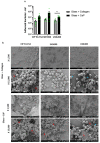Staphylococcus aureus Behavior on Artificial Surfaces Mimicking Bone Environment
- PMID: 36986306
- PMCID: PMC10056644
- DOI: 10.3390/pathogens12030384
Staphylococcus aureus Behavior on Artificial Surfaces Mimicking Bone Environment
Abstract
Infections, which interfere with bone regeneration, may be a critical issue to consider during the development of biomimetic material. Calcium phosphate (CaP) and type I collagen substrates, both suitable for bone-regeneration dedicated scaffolds, may favor bacterial adhesion. Staphylococcus aureus possesses adhesins that allow binding to CaP or collagen. After their adhesion, bacteria may develop structures highly tolerant to immune system attacks or antibiotic treatments: the biofilms. Thus, the choice of material used for scaffolds intended for bone sites is essential to provide devices with the ability to prevent bone and joint infections by limiting bacterial adhesion. In this study, we compared the adhesion of three different S. aureus strains (CIP 53.154, SH1000, and USA300) on collagen- and CaP-coating. Our objective was to evaluate the capacity of bacteria to adhere to these different bone-mimicking coated supports to better control the risk of infection. The three strains were able to adhere to CaP and collagen. The visible matrix components were more important on CaP- than on collagen-coating. However, this difference was not reflected in biofilm gene expression for which no change was observed between the two tested surfaces. Another objective was to evaluate these bone-mimicking coatings for the development of an in vitro model. Thus, CaP, collagen-coatings, and the titanium-mimicking prosthesis were simultaneously tested in the same bacterial culture. No significant differences were found compared to adhesion on surfaces independently tested. In conclusion, these coatings used as bone substitutes can easily be colonized by bacteria, especially CaP-coating, and must be used with an addition of antimicrobial molecules or strategies to avoid bacterial biofilm development.
Keywords: Staphylococcus aureus; adhesion; biofilm; bone substitutes.
Conflict of interest statement
The authors declare no conflict of interest.
Figures




References
-
- Li Y., Liu Y., Li R., Bai H., Zhu Z., Zhu L., Zhu C., Che Z., Liu H., Wanf J., et al. Collagen-based biomaterials for bone tissue engineering. Mat. Design. 2021;210:220049. doi: 10.1016/j.matdes.2021.110049. - DOI
-
- Masters E.A., Trombetta R.P., de Mesy Bentley K.L., Boyce B.F., Gill A.L., Gill S.R., Nishitani K., Ishikawa M., Morita Y., Ito H., et al. Evolving concepts in bone infection: Redefining “biofilm”, “acute vs. chronic osteomyelitis”, “the immune proteome” and “local antibiotic therapy”. Bone Res. 2019;7:20. doi: 10.1038/s41413-019-0061-z. - DOI - PMC - PubMed
Grants and funding
LinkOut - more resources
Full Text Sources
Molecular Biology Databases
Miscellaneous

